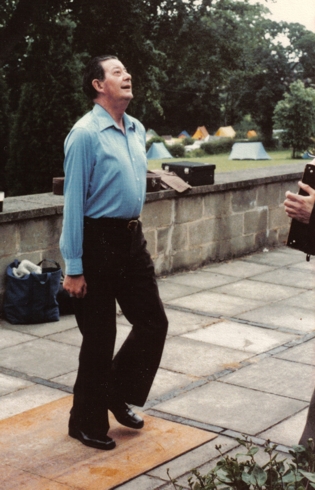Dick Hewitt
by Katie Howson & Peter Clifton
 This article in our series of portraits of singers and musicians from East Anglia is compiled by Katie Howson, co-founder of EATMT. It is based on obituaries written by Peter Clifton for the English Folk Dance & Song Society in 1995, used here with their permission.
This article in our series of portraits of singers and musicians from East Anglia is compiled by Katie Howson, co-founder of EATMT. It is based on obituaries written by Peter Clifton for the English Folk Dance & Song Society in 1995, used here with their permission.
Dick Hewitt (1921-1994) was a marvellous stepdancer from north Norfolk. Katie and John Howson were introduced to him by dance researchers Peter Clifton and Ann-Marie Hulme, and he was an occasional member of the Old Hat Concert Party in the 1980s. Peter described Dick as ‘a free-phrased stepdancer who could dance to any rhythm … his dancing had a natural ease of movement’.
“I first met Dick in 1977 at his home in Melton, Norfolk. I, together with Ann-Marie Hulme, had been researching into the dance tradition of the local area. It was not a good start. Dick had been working nights at the turkey farm and we called mid-morning. We agreed to meet later in a local pub. Despite assertions that he didn’t dance any more it was very obvious that he was a natural performer. He did not disappoint. Whether in the local pub – The Green Man, Briston, or with the Davies family from Cromer or on a formal occasion, the quality of his dancing was unsurpassed. A free-phrased step dancer who could dance to any rhythm. He later danced at folk festivals and at the Albert Hall. On each occasion his approach was thorough and professional.â€
“Dick learnt to step from an early age through his mother’s family, mainly his mother and uncle. He developed into a prodigious performer.â€
“His father, Albert, was a fine musician who played a variety of instruments. Albert was recorded by Seamus Ennis in 1958 for the BBC radio series ‘As I Roved Out’. It was this broadcast that brought Dick into contact with the English Folk Song and Dance Society through Russell Wortley … Dick was filmed on behalf of the EFDSS in 1979 for archival purposes. He dances to three rhythms – hornpipe, waltz and march – accompanied by Percy Brown, one of the ‘old-time’ players. It was filmed in the Green Man in Briston, the pub he used as his local for several years. He particularly enjoyed dancing to a slow waltz as he felt the slower pace and the rhythm enabled him to show his dancing to the full.â€
“Dick was a gregarious man. He spent 10 years as the publican of the Three Horseshoes in Briston. During this time a range of instruments were kept behind the bar. The pub was a favourite of the travellers. On many occasions, dancing, singing and playing would go on all night. Dick and his wife, Marion, were always very hospitable. Many a Saturday night was spent drinking and chatting in his local. Dick had a great sense of humour and was an inveterate optimist. He had been deeply affected by his wartime experiences, having spent a considerable amount of time as a Japanese prisoner of war. He said that he only survived the experience because he came from ‘sturdy Norfolk stock’. For me it was a privilege to know him and share an interest in the dance tradition.â€
Dick occasionally joined the Old Hat Concert Party for outings around the country in the 1980s, until ill health curtailed his activities.
A longer article about Dick is available on the Musical Traditions website, written by Chris Holderness. Another article by Chris – about the village of Southrepps – features a short soundclip of Dick dancing to Harry Baxter’s fddle playing, from a 1955 radio broadcast.
The BBC recordings of Dick’s father Albert playing the melodeon were available on the now defunct Folktrax label (Folktrax 328), and may become available again.
Photo: John Howson